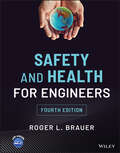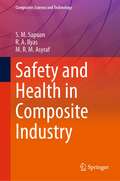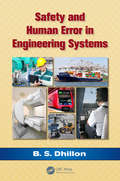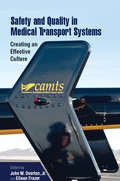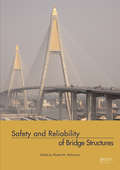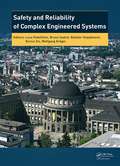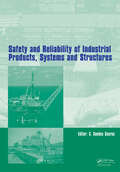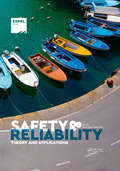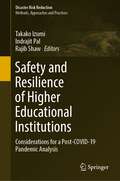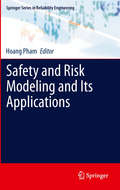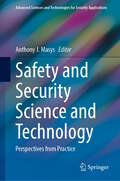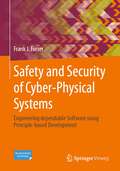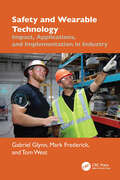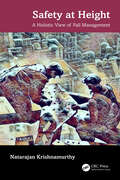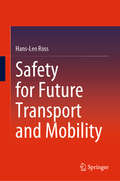- Table View
- List View
Safety and Health for Engineers
by Roger L. BrauerSAFETY AND HEALTH FOR ENGINEERS A comprehensive resource for making products, facilities, processes, and operations safe for workers, users, and the public Ensuring the health and safety of individuals in the workplace is vital on an interpersonal level but is also crucial to limiting the liability of companies in the event of an onsite injury. The Bureau of Labor Statistics reported over 4,700 fatal work injuries in the United States in 2020, most frequently in transportation-related incidents. The same year, approximately 2.7 million workplace injuries and illnesses were reported by private industry employers. According to the National Safety Council, the cost in lost wages, productivity, medical and administrative costs is close to 1.2 trillion dollars in the US alone. It is imperative—by law and ethics—for engineers and safety and health professionals to drive down these statistics by creating a safe workplace and safe products, as well as maintaining a safe environment. Safety and Health for Engineers is considered the gold standard for engineers in all specialties, teaching an understanding of many components necessary to achieve safe workplaces, products, facilities, and methods to secure safety for workers, users, and the public. Each chapter offers information relevant to help safety professionals and engineers in the achievement of the first canon of professional ethics: to protect the health, safety, and welfare of the public. The textbook examines the fundamentals of safety, legal aspects, hazard recognition and control, the human element, and techniques to manage safety decisions. In doing so, it covers the primary safety essentials necessary for certification examinations for practitioners. Readers of the fourth edition of Safety and Health for Engineers readers will also find: Updates to all chapters, informed by research and references gathered since the last publication The most up-to-date information on current policy, certifications, regulations, agency standards, and the impact of new technologies, such as wearable technology, automation in transportation, and artificial intelligence New international information, including U.S. and foreign standards agencies, professional societies, and other organizations worldwide Expanded sections with real-world applications, exercises, and 164 case studies An extensive list of references to help readers find more detail on chapter contents A solution manual available to qualified instructors Safety and Health for Engineers is an ideal textbook for courses in safety engineering around the world in undergraduate or graduate studies, or in professional development learning. It also is a useful reference for professionals in engineering, safety, health, and associated fields who are preparing for credentialing examinations in safety and health.
Safety and Health in Composite Industry (Composites Science and Technology)
by R.A. Ilyas S.M. Sapuan M.R.M. AsyrafThis book provides the latest developments on safety practices utilized in composite manufacturing facilities for students, workers, engineers, and other participants. It includes commentary from academic experts in the field who present cutting-edge research on advanced composite materials. Illustrations, figures, and tables are included in this book in order to make it easier for students, workers, engineers, and other participants to understand the contents of this book. The end user knows the safety and health that should be practiced in composite industry and their right in composite industry. Besides that, the composites industry players can upgrade their current safety system to the recommended practiced system. A lot of problems are solved by integrate the current system and advanced technology system from extensive research.
Safety and Health in Confined Spaces
by Neil McManusSafety and Health in Confined Spaces goes beyond all other resources currently available. International in scope, the 15 chapters and 10 appendices cover every facet of this important subject. A significant addition to the literature, this book provides a confined space focus to other health and safety concepts.Confined spaces differ from other workspaces because their boundary surfaces amplify the consequences of hazardous conditions. The relationship between the individual, the boundary surface, and the hazardous condition is the critical factor in the onset, outcome, and severity of accidents in these workspaces.The author uses information about causative and other factors from analysis of fatal accidents to develop a hazard assessment and hazard management system. He provides a detailed, disciplined protocol, covering 36 hazardous conditions, that addresses all segments of work--the undisturbed space, entry preparation, work activity, and emergency preparedness and response--and illustrates how to use it. Safety and Health in Confined Spaces gives you the tools you need for preventing and responding to accidents.
Safety and Human Error in Engineering Systems
by B.S. DhillonIn an approach that combines coverage of safety and human error into a single volume, Safety and Human Error in Engineering Systems eliminates the need to consult many different and diverse sources for those who need information about both topics. The book begins with an introduction to aspects of safety and human error and a discussion of mathemat
Safety and Human Resource Law for the Safety Professional (Occupational Safety & Health Guide Series)
by Thomas SchneidThe purpose of this text to provide a "one stop" source for safety professionals to acquire a general knowledge regarding not only the OSH Act but also laws and standards which impact the safety profession on a daily basis. The safety professional today does not work in a vacuum and decision-making can be impacted by a myriad of other laws. This new book will be the safety professional’s "go to" text to acquire a quick understanding of the particular law potentially impacting his/her daily activities. <p><p>Features <li>Includes safety laws as well as human resource laws <li>Presents new OSHA whistleblower actions <li>Encompasses updated contractor requirement under Wage and Hour laws <li>Covers new NLRA decisions and actions <li>Addresses e-commerce and social media issues involving the safety function
Safety and Quality in Medical Transport Systems: Creating an Effective Culture
by John W. Overton Eileen FrazerThe Commission on Accreditation of Medical Transport Systems (CAMTS) has been accrediting air and ground transport services since 1991. One of the most significant needs the Commission has recognized is to assist transport services in creating a culture that supports safety and quality for both crews and patients. Most of the helicopter EMS (emergency medical service) accidents and many ground ambulance accidents can be attributed to human factors and systems designs that lead to poor decision-making. Management commitment is vital to create and maintain a culture that supports risk assessment, accountability, professionalism and organizational dynamics. This reference book has been created by CAMTS to address this need directly and comprehensively. It offers a groundbreaking collection of expert insights and practical solutions that can be used by EMS, Fire and Rescue, public and private services, and professional emergency and transport professionals worldwide. Quoting from the foreword written by the late Robert L. Helmreich, Professor Emeritus of Psychology at The University of Texas Human Factors Research Project, 'This is an important book which should be required reading for everyone involved in patient transport, from managers and dispatchers to those at the sharp end... The experienced and able authors and editors of this work use culture as the overarching concept needed to maximize safety while delivering patients expeditiously.'
Safety and Reliability in the Oil and Gas Industry: A Practical Approach
by B.S. DhillonAn Insightful Guide to Avoiding Offshore Oil- and Gas-Industry Disaster Designing, constructing, operating, and maintaining offshore oil and gas industry equipment and systems can sometimes result in accidents, injuries, and other serious problems. Safety and Reliability in the Oil and Gas Industry: A Practical Approach focuses on oil and gas indus
Safety and Reliability of Bridge Structures
by Khaled M. MahmoudRecent surveys of the U.S. infrastructure‘s condition have rated a staggering number of bridges structurally deficient or functionally obsolete. While not necessarily unsafe, a structurally deficient bridge must be posted for weight and have limits for speed, due to its deteriorated structural components. Bridges with old design features that canno
Safety and Reliability of Complex Engineered Systems: ESREL 2015
by Wolfgang Kröger Enrico Zio Luca Podofillini Bruno Sudret Božidar StojadinovićSafety and Reliability of Complex Engineered Systems contains the Proceedings of the 25th European Safety and Reliability Conference, ESREL 2015, held 7-10 September 2015 in Zurich, Switzerland. Including 570 papers on theories and methods in the area of risk, safety and reliability, and their applications to a wide range of industrial, civil and social sectors, this book will be of interest to academics and professionals involved or interested in aspect of risk, safety and reliability in various engineering areas.
Safety and Reliability of Industrial Products, Systems and Structures
by C. Guedes SoaresSafety and Reliability of Industrial Products, Systems and Structures deals with risk assessment, which is a fundamental support for decisions related to the design, construction, operation and maintenance of industrial products, systems and infrastructures. Risks are influenced by design decisions, by the process of construction of systems and inf
Safety and Reliability. Theory and Applications
by Radim Bris Marko CepinSafety and Reliability – Theory and Applications contains the contributions presented at the 27th European Safety and Reliability Conference (ESREL 2017, Portorož, Slovenia, June 18-22, 2017). The book covers a wide range of topics, including:• Accident and Incident modelling• Economic Analysis in Risk Management• Foundational Issues in Risk Assessment and Management• Human Factors and Human Reliability• Maintenance Modeling and Applications• Mathematical Methods in Reliability and Safety• Prognostics and System Health Management• Resilience Engineering• Risk Assessment• Risk Management• Simulation for Safety and Reliability Analysis• Structural Reliability• System Reliability, and• Uncertainty Analysis. Selected special sessions include contributions on: the Marie Skłodowska-Curie innovative training network in structural safety; risk approaches in insurance and fi nance sectors; dynamic reliability and probabilistic safety assessment; Bayesian and statistical methods, reliability data and testing; oganizational factors and safety culture; software reliability and safety; probabilistic methods applied to power systems; socio-technical-economic systems; advanced safety assessment methodologies: extended Probabilistic Safety Assessment; reliability; availability; maintainability and safety in railways: theory & practice; big data risk analysis and management, and model-based reliability and safety engineering. Safety and Reliability – Theory and Applications will be of interest to professionals and academics working in a wide range of industrial and governmental sectors including: Aeronautics and Aerospace, Automotive Engineering, Civil Engineering, Electrical and Electronic Engineering, Energy Production and Distribution, Environmental Engineering, Information Technology and Telecommunications, Critical Infrastructures, Insurance and Finance, Manufacturing, Marine Industry, Mechanical Engineering, Natural Hazards, Nuclear Engineering, Offshore Oil and Gas, Security and Protection, Transportation, and Policy Making.
Safety and Reliability: Methodology and Applications
by Tomasz Nowakowski Sylwia Werbińska-Wojciechowska Anna Jodejko-Pietruczuk Marek MłyńczakWithin the last fifty years the performance requirements for technical objects and systems were supplemented with: customer expectations (quality), abilities to prevent the loss of the object properties in operation time (reliability and maintainability), protection against the effects of undesirable events (safety and security) and the ability to
Safety and Resilience of Higher Educational Institutions: Considerations for a Post-COVID-19 Pandemic Analysis (Disaster Risk Reduction)
by Rajib Shaw Takako Izumi Indrajit PalThe world has spent the majority of 2020 enduring an unpreceded crisis caused by the COVID-19 pandemic. The impact of this crisis has been enormous, and the situation has yet to be resolved. It is still difficult to anticipate when the pandemic will end and how our lives will have changed after the crisis.Higher educational institutions (HEIs) have also had to undergo tremendous transformation, in particular, changing a conventional educational, teaching, and learning system to a digital and online mode and cancelling or postponing important events such as graduation and entrance ceremonies and entrance examinations. In addition, a number of HEIs have been facing financial constraints due to reduced enrolment, particularly from overseas. Students have missed opportunities to meet their family and friends, causing profound psychosocial impact and stress for all concerned.Simultaneously, however, the situation has given HEIs a good opportunity to consider their disaster preparedness, response, and recovery capacity on campus. Some surveys have highlighted a lack of preparedness for pandemic and other hazardous risks beyond natural hazards. Safety issues are a top priority at HEIs because they bring together a number of students, faculty, and staff.This book covers the experiences and lessons learned from HEIs in preparedness, response, and recovery during the COVID-19 pandemic to prepare for such calamities beyond natural disasters in the future. The book consists of 15 chapters divided into three major sections. They highlight the importance of HEIs’ governance issues in disaster risk management, examine the challenges that HEIs have faced during the pandemic and the implementation of new teaching and learning methodologies, and provide innovative responses and preparedness by HEIs based on science and technology, respectively.
Safety and Risk Modeling and Its Applications
by Hoang PhamSafety and Risk Modeling presents the latest theories and methods of safety and risk with an emphasis on safety and risk in modeling. It covers applications in several areas including transportations and security risk assessments, as well as applications related to current topics in safety and risk. Safety and Risk Modeling is a valuable resource for understanding the latest developments in both qualitative and quantitative methods of safety and risk analysis and their applications in operating environments. Each chapter has been written by active researchers or experienced practitioners to bridge the gap between theory and practice and to trigger new research challenges in safety and risk. Topics include: safety engineering, system maintenance, safety in design, failure analysis, and risk concept and modelling. Postgraduate students, researchers, and practitioners in many fields of engineering, operations research, management, and statistics will find Safety and Risk Modeling a state-of-the-art survey of reliability and quality in design and practice.
Safety and Security Science and Technology: Perspectives from Practice (Advanced Sciences and Technologies for Security Applications)
by Anthony J. MasysGlobal security threats have created a complex risk landscape that is challenging and transforming society. These global security issues intersect and influence the political, economic, social, technological, ecological and legal dimensions of the complex risk landscape and are now transborder thereby becoming national security issues. Accessing the innovation space to support safety, security and defence capabilities is critical in order to mitigate new and evolving threats.Through real-world examples of innovation, this book provides a detailed examination of the innovation space as it pertains to the application of S&T to safety and security threats and challenges. This book is of most interest to public and private sector innovators as well as academician and graduate students working in the safety and security domain.
Safety and Security of Cyber-Physical Systems: Engineering dependable Software using Principle-based Development
by Frank J. FurrerCyber-physical systems (CPSs) consist of software-controlled computing devices communicating with each other and interacting with the physical world through sensors and actuators.Because most of the functionality of a CPS is implemented in software, the software is of crucial importance for the safety and security of the CPS. This book presents principle-based engineering for the development and operation of dependable software.The knowledge in this book addresses organizations that want to strengthen their methodologies to build safe and secure software for mission-critical cyber-physical systems.The book:• Presents a successful strategy for the management of vulnerabilities, threats, and failures in mission-critical cyber-physical systems;• Offers deep practical insight into principle-based software development (62 principles are introduced and cataloged into five categories: Business & organization, general principles, safety, security, and risk management principles);• Provides direct guidance on architecting and operating dependable cyber-physical systems for software managers and architects.
Safety and Wearable Technology: Impact, Applications, and Implementation in Industry
by Tom West Gabriel Glynn Mark FrederickSafety and Wearable Technology tackles the profound issue of workplace safety, as each day unacceptable numbers of workers lose their lives in accidents, with even more succumbing to work-related illnesses across the globe. Many safety professionals strive to reduce these risks, but they’re often hindered by limited resources, time, and information to catch hazards before tragedy strikes. With wearable technology now readily available, a new frontier has opened for workplace safety, offering powerful tools that can change how we protect workers.In this book, three experts in wearable technology explore the critical role wearables play in enhancing workplace safety. They walk the reader through the traditional challenges of safety management, making a strong case for the adoption of wearable technology. The book covers every essential aspect of implementing wearables in the workplace; from selecting the right technology and understanding technical approaches to effective deployment and long-term safety management. It also addresses the leadership necessary to harness these advancements fully. Readers will gain insights into the innovations driving wearable technology, including sensors, machine learning, deep analytics, and artificial intelligence. As data-driven approaches redefine safety management, this book empowers safety professionals to gather actionable data, predict hazards, and intervene before incidents occur. This data-driven shift not only enhances safety but also redefines what the factory of the future can look like – a workplace where technology proactively protects workers.Intended for professionals across the safety, operations, and engineering fields, Safety and Wearable Technology will appeal to Health and Safety Engineers, Manufacturing Engineers, Plant Managers, Industrial Hygienists, Risk Managers, and many others looking to understand and implement wearable technology in their safety protocols. This guide is an indispensable resource for those ready to envision and create safer, smarter, and more connected workplaces.
Safety and environmental issues in rock engineering, volume 2: Proceedings / Comptes-rendus / Sitzungsberichte / ISRM international symposium, EUROCK '93, Lisbon, 21-24 June 1993, 2 volumes
by L. RIBEIRO E SOUSA; N. F. GROSSMANNState-of-the-art in science; engineering aspects of rock mechanics in the areas of safety ; environmental protection. Discusses various aspects concerning modelling in safety analysis, stability of underground structures, and the contribution of incident and accident cases to the progress of rock engineering activities. The influence of the environment is also considered, namely in heat ; mass transport, contaminant migration, and underground storage of waste; products.
Safety at Height: A Holistic View of Fall Management
by Natarajan KrishnamurthyEverybody climbs up or down for some reason or other. Many fall and get injured or, worse, end up killed all over the world, especially in their place of work. Why does it happen? Does it have to be so? Can it be managed better and, if so, how? This book addresses these questions in layman’s language, yet with sufficient technical detail to satisfy the more curious and challenge the more ambitious.In Safety at Height: A Holistic View of Fall Management, veteran author Natarajan Krishnamurthy shares his long research and consultancy experience on this subject to offer an overview of falls, methods to manage them, and practical techniques to ensure better safety. This book argues that deaths and major injuries from fall accidents can be prevented by stakeholders knowing more and following guidelines. It looks at the mechanics of falls, accidents in the workplace, and safeguards that can be put in place. Featuring exercises at the end of chapters to underpin learning, this title concludes with unusual fall situations. Through its pages, the reader will develop a good understanding of how to prevent falls across a variety of different real-life scenarios.This handy guide will be an ideal read for students, researchers, and professionals in occupational safety and health, human factors, and activities where slips, trips, and falls tend to occur.
Safety at Work and Emergency Control: A Holistic Approach Second Edition
by Benedito CardellaThis book treats 'the accident' as a multifaceted phenomenon, resulting from complex interactions between physical, biological, psychological, cultural and social factors. Addressing safety with holistic vision, it combines two complementary approaches: the reductionist, to study the factors in detail, and the systemic, to understand how they interrelate. It includes 33 concepts that provide a clear and logical understand of every factor involved in any activity or situation regarding safety. The author developed concepts and methods to boost safety performance. Organizational field, adherence and administrative game explain why things happen or not happen in the organizations. The aggressive function integrates value analysis and risk analysis. An individual adopts a safe or unsafe behavior the same way he decides to buy a product or another. Safety is a function placed at the same importance as its sisters, productivity, quality, environmental preservation and human development. Risk is a process variable and as such one can control it. Presents a set of 33 concepts that provide a clear and logical understanding of every factor involved in any activity or situation regarding safety Discusses risk as a variable associated with any activity, and that it can be controlled similarly to any process variable, such as temperature or pressure Uses the concepts of value analysis and value engineering when thinking about safety Provides directions on how to integrate the safety function into the mission of any organization, and into other vital functions of the organizations Addresses safety with a holistic vision, as it's central element
Safety at Work: For Occupational Health And Safety (Safety At Work Ser. #Vol. 1)
by John ChanningThe leading book on the subject of occupational health & safety revised in line with recent UK legislation and practice. New to this edition is the foreword by Judith Hackitt CBE, Chair of the Health and Safety Executive and a brand new chapter on the latest EU and international regulations and directives. Safety at Work is widely accepted as the most authoritative guide to health and safety in the workplace. Offering detailed coverage of the fundamentals and background in the field, this book is essential reading for health and safety professionals or small company owners. Students on occupational health and safety courses at diploma, bachelor and masters level, including the NEBOSH National Diploma, will find this book invaluable, providing students with the technical grounding required to succeed. Edited by an experienced and well-known health and safety professional with contributions from leading experts in research and practice.
Safety at the Sharp End: A Guide to Non-Technical Skills
by Paul O'Connor Rhona FlinMany 21st century operations are characterised by teams of workers dealing with significant risks and complex technology, in competitive, commercially-driven environments. Informed managers in such sectors have realised the necessity of understanding the human dimension to their operations if they hope to improve production and safety performance. While organisational safety culture is a key determinant of workplace safety, it is also essential to focus on the non-technical skills of the system operators based at the 'sharp end' of the organisation. These skills are the cognitive and social skills required for efficient and safe operations, often termed Crew Resource Management (CRM) skills. In industries such as civil aviation, it has long been appreciated that the majority of accidents could have been prevented if better non-technical skills had been demonstrated by personnel operating and maintaining the system. As a result, the aviation industry has pioneered the development of CRM training. Many other organisations are now introducing non-technical skills training, most notably within the healthcare sector. Safety at the Sharp End is a general guide to the theory and practice of non-technical skills for safety. It covers the identification, training and evaluation of non-technical skills and has been written for use by individuals who are studying or training these skills on CRM and other safety or human factors courses. The material is also suitable for undergraduate and post-experience students studying human factors or industrial safety programmes.
Safety at the Sharp End: A Guide to Non-Technical Skills
by Paul O'Connor Rhona Flin Tom ReaderMany 21st-century operations are characterized by teams of workers dealing with significant risks and complex technology, in competitive, commercially driven environments. Informed managers have realized the necessity of understanding the human dimension of their operations if they hope to improve production and safety performance. A key aspect is the non-technical skills of the system operators based at the ‘sharp end’ of the organization. These include the cognitive and social skills required for safe and efficient performance, often termed ‘Crew Resource Management (CRM) skills’.This book is a general guide to the theory and practice of non-technical skills (NTS) for safety. Now fully updated in this new edition, Safety at the Sharp End: A Guide to Non-Technical Skills considers the growth of interest in Crew Resource Management (CRM) approaches to identifying, training and assessing CRM/NTS skills. It covers the identification, training and evaluation of NTS and has been written for use by individuals who are studying or training these skills in CRM and other safety or human factors courses. It outlines the underlying principles, as well as practical techniques and advice and has been revised to cover the latest developments by drawing on a wider sample of work settings where an NTS approach is being adopted. A full literature review is offered, and the authors have drawn upon an international network of contacts across industry, military and healthcare occupations and academic sources to deliver current practice and emerging issues. The reader will develop a thorough understanding of the theory and practice of non-technical skills for safety from this title.This book is an ideal read for professionals and those practising or studying human factors or industrial safety programmes. Its appeal will extend to those in safety-critical industries including healthcare, aviation, rail, maritime, energy production and the military. This book:• Delivers a comprehensive and accessible guide on non-technical skills (NTS) for practitioners.• Focuses on the latest scientific evidence for each skill category written in an accessible manner.• Explains the application of an NTS approach across a wide range of occupations.• Covers the authors’ extensive research and experience of collaborating with practitioners across a range of higher risk work settings resulting in practical examples throughout the text.• Details a good range of sources provided for further reading and additional information.
Safety by Accident
by Tracy Vonder BrinkHow did forgetting to wash a jar make cars safer? A scientist named Édouard Bénédictus accidentally dropped a plastic-coated flask that did not break. This invention was tested and engineered to help today's windshields protect drivers better.
Safety for Future Transport and Mobility
by Hans-Leo RossThe book provides background information about technical solutions, processes and methodology to develop future automated mobility solutions. Beginning from the legal requirements as the minimum tolerable risk level of the society, the book provides state-of-the-art risk-management methodologies. The system engineering approach based on todays engineering best practices enhanced by principles derived from cybernetics. The approach derived from the typical behaviour of a human driver in public road traffic to a cybernetical based system engineering approach. Beyond the system engineering approach, a common behaviour model for the operational domain will show aspects how to extend the system engineering model with principles of cybernetics. The role and the human factors of road traffic participants and drivers of motor vehicles are identified and several viewpoints for different observers show how such mixed traffic scenarios could be assessed and optimised. The influence of the changing mobility demands of the society and the resulting changes to the origination of producer, owner, driver and supplier show aspects for future liability and risk share option for new supply chains. Examples from various industries provide some well-proven engineering principles how to adapt those for the future mobility for the benefit of the users. The aim of the book is to raise awareness that the safety provided by a product, a means of transport or a system up to an entire traffic system depends on the capabilities of the various actors. In addition to the driver and passengers, there are also other road users, maintenance personnel and service providers, who must have certain abilities to act safely in traffic. These are also the capabilities of the organisation, not only the organisation that develops or brings the product to market, but also the organisation that is responsible for the operation and the whole lifecycle of the products. The book is for people who want to get involved in the mobility of the future. People, that have ideas to become a player who want to help shape the future mobility of society and who want to bring responsible solutions for users into the market.
